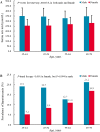Prevalence and associated factors of hyperuricemia among urban adults aged 35-79 years in southwestern China: a community-based cross-sectional study
- PMID: 32973308
- PMCID: PMC7515884
- DOI: 10.1038/s41598-020-72780-3
Prevalence and associated factors of hyperuricemia among urban adults aged 35-79 years in southwestern China: a community-based cross-sectional study
Abstract
Hyperuricemia is prevalent throughout the world. However, a well-designed large-scale epidemiological investigation of hyperuricemia in southwestern China is lacking. A regional representative sample of 10,141 participants were included using multistage, stratified sampling in Chengdu and Chongqing from September 2013 to March 2014. Hyperuricemia was defined as the self-reported of the doctor's diagnosis of hyperuricemia, or serum uric acid > 420 μmol/L in men or serum uric acid > 360 μmol/L in women. The overall age- and sex-standardized prevalence of hyperuricemia among adults aged 35-79 years was 13.5%. Compared with women, the prevalence of hyperuricemia in men was higher (17.3% versus 10.0%). Hypertension, hyperlipidemia, overweight or obesity, central obesity were associated with an increased risk for hyperuricemia both in men and in women. Married men and women were not susceptible to hyperuricemia. Current cigarette smoking was an associated risk factor of hyperuricemia only in women. Hyperuricemia has become a major health problem among urban adults aged 35-79 years in southwestern China, and special attention should be paid to men. Comorbidities associated with hyperuricemia and causality worth further investigation.
Conflict of interest statement
The authors declare no competing interests.
Figures
Similar articles
-
High prevalence and low awareness of hyperuricemia in hypertensive patients among adults aged 50-79 years in Southwest China.BMC Cardiovasc Disord. 2022 Jan 6;22(1):2. doi: 10.1186/s12872-021-02427-2. BMC Cardiovasc Disord. 2022. PMID: 34991490 Free PMC article.
-
Prevalence of hyperuricemia among Chinese adults: a national cross-sectional survey using multistage, stratified sampling.J Nephrol. 2014 Dec;27(6):653-8. doi: 10.1007/s40620-014-0082-z. Epub 2014 Apr 1. J Nephrol. 2014. PMID: 24687401
-
The prevalence of hyperuricemia in a population of the coastal city of Qingdao, China.J Rheumatol. 2006 Jul;33(7):1346-50. J Rheumatol. 2006. PMID: 16821269
-
Demographic, regional and temporal trends of hyperuricemia epidemics in mainland China from 2000 to 2019: a systematic review and meta-analysis.Glob Health Action. 2021 Jan 1;14(1):1874652. doi: 10.1080/16549716.2021.1874652. Glob Health Action. 2021. PMID: 33475474 Free PMC article.
-
Recent progress and perspectives on the relationship between hyperuricemia and periodontitis.Front Immunol. 2022 Nov 16;13:995582. doi: 10.3389/fimmu.2022.995582. eCollection 2022. Front Immunol. 2022. PMID: 36466813 Free PMC article. Review.
Cited by
-
The dose-response relationship between sex hormones and hyperuricemia in different gender: NHANES 2013-2016.Front Endocrinol (Lausanne). 2022 Nov 1;13:1035114. doi: 10.3389/fendo.2022.1035114. eCollection 2022. Front Endocrinol (Lausanne). 2022. PMID: 36387910 Free PMC article.
-
Prevalence of Hyperuricemia and Its Association with Cardiovascular Risk Factors and Subclinical Target Organ Damage.J Clin Med. 2022 Dec 21;12(1):50. doi: 10.3390/jcm12010050. J Clin Med. 2022. PMID: 36614852 Free PMC article.
-
Risk factors and management of hyperuricemia after renal transplantation.Front Surg. 2023 Jan 6;9:956213. doi: 10.3389/fsurg.2022.956213. eCollection 2022. Front Surg. 2023. PMID: 36760666 Free PMC article. Review.
-
Hyperuricaemia Prevalence Rates According to Their Physiochemical and Epidemiological Diagnostic Criteria and Their Associations with Cardio-Renal-Metabolic Factors: SIMETAP-HU Study.J Clin Med. 2024 Aug 19;13(16):4884. doi: 10.3390/jcm13164884. J Clin Med. 2024. PMID: 39201026 Free PMC article.
-
Prevalence and influencing factors of hyperuricemia in middle-aged and older adults in the Yao minority area of China: a cross-sectional study.Sci Rep. 2023 Jun 22;13(1):10185. doi: 10.1038/s41598-023-37274-y. Sci Rep. 2023. PMID: 37349536 Free PMC article.
References
MeSH terms
Substances
LinkOut - more resources
Full Text Sources


